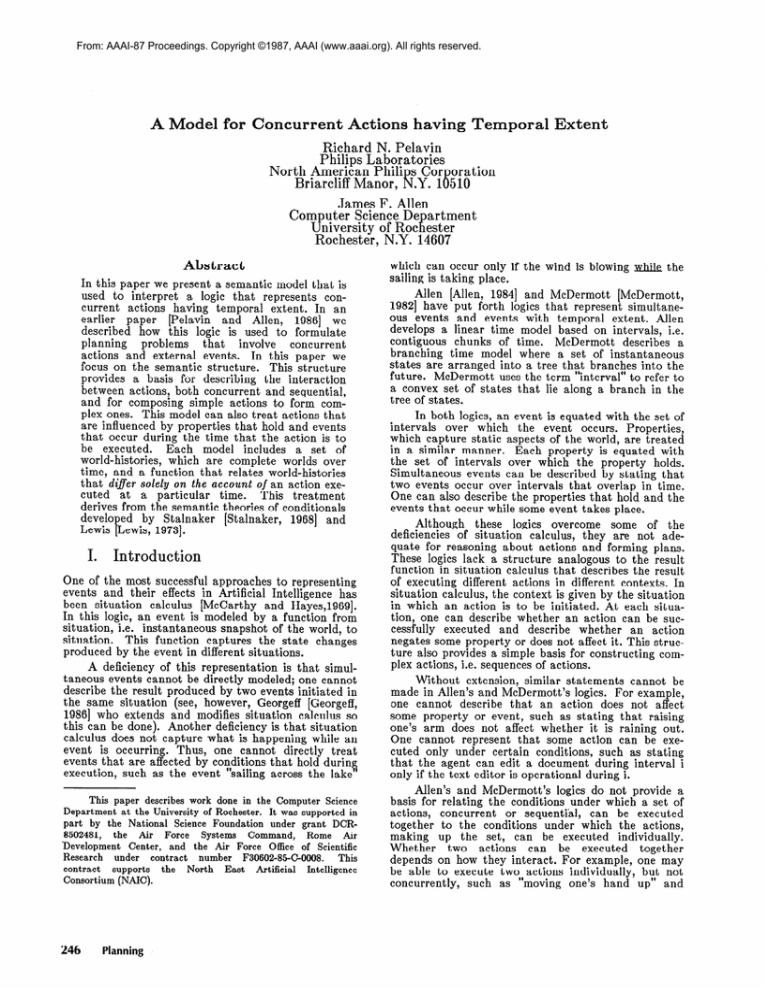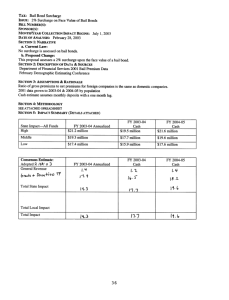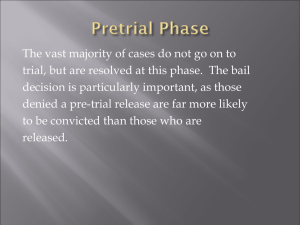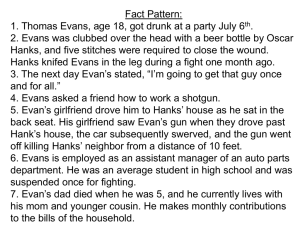
From: AAAI-87 Proceedings. Copyright ©1987, AAAI (www.aaai.org). All rights reserved.
A Model
for Concurrent
Actions
having
Temporal
Extent
Richard N. Pelavin
Philips Laboratories
North American Phili s Cor oration
Briarcliff Manor, RLY. 18510
James F. Allen
Corn uter Science De artment
8 niversity of Rot Kester
Rochester, N.Y. 14607
Abstract
In this paper we present a semantic
model that is
used to interpret
a logic that represents
concurrent
actions
having
temporal
extent.
In an
earlier
paper
[Pelavin
and Allen,
19861 we
described
how this logic is used to formulate
planning
problems
that
involve
concurrent
actions
and external
events.
In this paper we
focus on the semantic
structure.
This structure
provides
a basis for describing
the interaction
between
actions, both concurrent
and sequential,
and for composing
simple actions to form complex ones. This model can also treat actions that
are influenced
by properties
that hold and events
that occur during the time that the action is to
be executed.
Each
model
includes
a set of
world-histories,
which are complete
worlds over
time, and a function
that relates world-histories
that differ solely on the account of an action executed
at a particular
time.
This treatment
derives from the semantic
theories of conditionals
developed
by Stalnaker
[Stalnaker,
19681 and
Lewis [Lewis, 19731.
I.
Introduction
One of the most successful
approaches
to representing
events
and their effects in Artificial
Intelligence
has
been situation
calculus
[McCarthy
and Hayes,1969].
In this logic, an event is modeled by a function
from
situation,
i.e. instantaneous
snapshot
of the world, to
situation.
This function
captures
the state
changes
produced
by the event in different situations.
A deficiency
of this representation
is that simultaneous events cannot be directly modeled; one cannot
describe the result produced
by two events initiated
in
the same situation
(see, however,
Georgeff [Georgeff,
19861 who extends
and modifies situation
calculus so
this can be done). Another
deficiency is that situation
calculus does not capture what is happening
while an
event
is occurring.
Thus, one cannot
directly
treat
events that are affected by conditions
that hold during
execution,
such as the event “sailing across the lake ’
This paper describes work done in the Computer Science
Department
at the University of Rochester.
It was supported in
part by the National
Science Foundation
under grant DCR8502481,
the
Air
Force
Systems
Command,
Rome
Air
Development
Center,
and the Air Force
Office of Scientific
Research
under
contract
number
F30602-85-C-0008.
This
contract
supports
the
North
East
Artificial
Intelligence
Consortium (NAIC).
246
Planning
which can occur only if the wind is blowing while the
sailing is taking place.
Allen [Allen, 19841 and McDermott
[McDermott,
simultane19821 have put forth logics that represent
ous events
and events
with temporal
extent.
Allen
develops
a linear time model based on intervals,
i.e.
contiguous
chunks
of time.
McDermott
describes
a
branching
time model where a set of instantaneous
states are arranged
into a tree that branches
into the
future.
McDermott
uses the term “interval” to refer to
a convex set of states that lie along a branch in the
tree of states.
In both logics, an event is equated with the set of
intervals
over which
the event
occurs.
Properties,
which capture static aspects of the world, are treated
in a similar manner.
Each property
is equated
with
the set of intervals
over which the property
holds.
Simultaneous
events can be described
by stating
that
two events occur over intervals
that overlap in time.
One can also describe the properties
that hold and the
events that occur while some event takes place.
Although
these
logics overcome
some
of the
deficiencies
of situation
calculus,
they are not adequate for reasoning
about actions and forming plans.
These logics lack a structure
analogous
to the result
function
in situation
calculus that describes
the result
of executing
different
actions in different
contexts.
In
situation
calculus, the context is given by the situation
in which an action is to be initiated.
At each situation, one can describe whether
an action can be successfully
executed
and describe
whether
an action
negates some property
or does not affect it. This structure also provides a simple basis for constructing
complex actions, i.e. sequences of actions.
Without
extension,
similar statements
cannot
be
made in Allen’s and McDermott’s
logics. For example,
one cannot
describe
that an action
does not affect
some property
or event, such as stating
that raising
one’s arm does not affect whether
it is raining out.
One cannot
represent
that some action can be executed only under certain
conditions,
such as stating
that the agent can edit a document
during interval
i
only if the text editor is operational
during i.
Allen’s and McDermott’s
logics do not provide a
basis for relating
the conditions
under which a set of
actions,
concurrent
or sequential,
can be executed
together
to the conditions
under which the actions,
individually.
making
up the set, can be executed
Whether
two
actions
can
be executed
together
depends
on how they interact.
For example, one may
be able to execute
two actions
individually,
but not
concurrently,
sue h as “moving one’s hand up” and
“moving one’s hand down”. It might be the case that
two actions can be executed
together
only under certain conditions,
such as two concurrent
actions that
share
the
same
type
of resource.
Allen’s
and
McDermott’s
logics can express “if actions al and a2
both occur during i, then there must be at least two
resources
available
during i”. These logics, however,
cannot
distinguish
whether
“there are at least two
resources
available
during i” is a necessary
condition
that must hold in order to execute al and a2 together,
or whether
this condition
is an effect produced
by the
joint execution
of al and a2. A detailed
discussion
of
these issues is given in [Pelavin, 1987l.l
To remedy these problems, we develop a semantic
model that
contains
a structure
analogous
to the
result function
in situation
calculus.
In our models,
world-histories
and action instances take the place of
situations
and actions.
A world-history
refers to a
complete
world over time, rather than an instantanerefers to an action
An action instance,
ous snapshot.
to be performed
at a specified
time. A world-history
serves as the context
in which the execution
of an
action instance
is specified.
This enables us to model
the influence
of conditions
that may hold during the
time that an action instance is to be executed,
and, as
we will see, provides a simple basis for modeling concurrent
interactions
and for defining the joint execution of a set of action instances.
To describe
these
models,
we extend
Allen’s
language,
which is a first order language,
with two
In this paper, we only describe the
modal operators.
underlying
semantic
structure
and do not discuss the
syntax
or interpretation
of this
modal
language.
Moreover,
we focus on the portion of the model that
pertains
to modeling
actions,
after briefly describing
the other components
in the model structure.
The
reader interested
in the language,
axiomatics,
or other
details
omitted
in this paper can refer to [Pelavin,
19871 and [Pelavin and Allen, 19861.
II.
Overview of the model structure
In each model, a set of world-histories
and set of temporal intervals
are identified.
Each temporal
interval
picks out a common
time across the set of worldhistories.
The intervals
are arranged
by the MEETS
relation
to form a global
date
line. The relation
MEETS(il,i2)
is true if interval i1 is immediately
prior
to interval
iZ. In [Allen and Hayes, 19851, it is shown
that all temporal
interval
relations,
such as ‘*overlaps
to the right’ and “starts”,
can be defined in terms of
MEETS.
The model identifies
the set of properties
and
events
that
hold (occur)
at various
times
in the
different world-histories.
Formally,
events and properties are sets of ordered pairs, each formed by an interval and a world-history.
If <i,h>
E eu, then event ev
occurs during intervai
i in world-history
h. Similarly,
if <i,h>
E pr, then property
pr holds during interval i
in world-history
h. To capture
the relation
“if property pr holds over an interval
i then pr holds over all
intervals
contained
in i’, we restrict
the models so
1 For example, in [Pelavin, 19871 we show why a branching
time model cannot
be used to interpret
“action al can be
executed
during time i if we want to treat actions, such as
“sailing”, that are influenced by conditions
that hold during
execution.
that if il is contained
in i%! and <i2,h>
E pr, then
<il,h>
E pr.
World-histories
are arranged
into
trees
that
branch into the future by the R accessibility
relation
which takes
an interval
and two world-histories
as
arguments.
Intuitively,
R(i,hl,h2)
means that hl and
hi? share a common
past through the end of interval
i
and are possible with respect to each other at i. This
structure
is identical
to one found in [Haas, 19851 with
the exception
that Haas uses a time point to relate
world-theories,
rather
than the end of an interval.
Constraints
are placed on R to insure that i) it is an
equivalence
relation
for
a fixed
interval,
ii) if
R(il,hl,h2),
then h1 and h2 agree on all events and
properties
that end before or at the same time as i1,
and iii) if R(il,hl,h2),
then R(i2,hl,h2)
for all intervals
i,$!that end at the same time as or before iI.
In situation
calculus, the execution of an action is
given with respect
to a situation,
and an action is
modeled
as a function
from situation
to situation.
In
our model, the execution
of an action instance
is given
with respect to a world-history,
and an action instance
is modeled
as a function
from world-history
to set of
world-histories.
The rest of the paper is devoted
to
describing
this function
and showing how a function
associated
with a set of action instances
can be con
strutted
from
the
functions
associated
with
its
members.
In this paper, we will only discuss a type of action
Basic actions
instance
called a basic action instance.
[Goldman,
19701 refer to actions that are primitive
in
the sense that all non-basic
actions are brought about
by performing
one or more
basic
actions
under
appropriate
conditions.
In [Pelavin, 19871, we describe
how all other action instances
(which we refer to as
“plan instances”)
are defined in terms of basic action
instances.
III.
The I?,, function
The result of executing
a basic action instance
with
respect to a world-history
is given by the F,, function.
F,l takes
a basic action
instance
bai and a worldhistory
h as arguments
and yields a nonempty
set of
world-histories
that
“differ from
h solely
on the
account of the occurrence
of bai’. Equivalently,
we say
that the world-histories
belonging to F,l(bai,h)
are the
“closest
world-histories’*
basic
action
to h where
instance
bai occurs.
The term ‘*closest” is a vestige
from Stalnaker’s
[Stalnaker,
1968 and Lewis’ [Lewis,
19731 semantic
theories
of con clitionals
from which
our treatment
derives.
In the remainder
of this section, we explain what
we mean by “differing solely on the account
of the
occurrence
of a basic action instance”
and present the
constraints
that are imposed on F,l in accordance
with
these
intuitions.
Very
briefly,
if h2 belongs
to
F,l(bai,h),
then h and h2 will coincide on all conditions
that are not affected by the occurrence
of bai. This
includes conditions
o;lt of the agent’s control, such as
whether
or not it is raining during some interval,
and
conditions
that only refer to times that end before bai.
One reason
that F,l yields a set of world-histories,
rather
than
a single one, is to provide
for nondeterministic
basic actions.
Another
reason for treating F,l as a set is explained
later.
Pelavin and Allen
247
We use a term of the form “bu@i* to refer to a
basic action instance
whose time of occurrence
is i.
The treatment
of F,l(ba@i,h)
is trivial when baai
occurs in h. In this case, F,l(ba@i,h)
is equal to {h}
reflecting the principle that a world-history
is closer to
itself than any other world-history.
This is captured
Gove;
following
constraint
which is imposed on our
..
BAl)
For all basic action instances (ba@i),
and world-histories (h), if h E OC(ba@i),
then F,l(ba@i,h)
= {h}
where OC(ba@i)
is the set of world-histories
in which ba@i occurs
is also set to {h} when bu@i’s stundo not hold in h. The term “standard
conditions”
is taken from Goldman
[Goldman,
19701
although
we use it in more general
way.
A basic
action’s standard
conditions
are conditions
that must
hold in order to execute the action.
For example, the
standard
conditions
for “the agent moves its right arm
up during time i’ include the condition that the arm is
condinot broken during time i. We also use standard
tions to refer to the conditions
under which a move is
legal when modeling a board game.
If bu@z’s standard
conditions
do not hold in h,
then F,l(ba@i,h),
which equals {h}, contains
a worldhistory
in which bu@i does not occur.
In effect, if
bu@Zs standard
conditions
do not occur in h, we are
“the closest
world-history
to h where
not defining
We treat the lack of standard
condibai@i occurs”.
tions this way because we want to restrict F,l so that
if hi? belongs to F,l(ba@i,h)
then hi! and h agree on all
conditions
that are not affected, directly or indirectly,
This restriction
would be violated if bai@i’s
by bu@i.
standard
conditions
did not hold in h, but F,l(bai@i,h)
hi? where baai occurs.
This
contained
a world-history
stems from an assumption
that a basic action cannot
affect whether or not its own standard
conditions
hold.
result
when
F,l(ba@i,h)
yields
a non-trivial
b&$‘s
standard
conditions
hold in h, but bu@i does
not occur in h. In this case, all the members belonging
to F,l(ba@i,h)
differ from h and bu@i occurs in all
these world-histories.
Consequently,
we impose
the
following constraint:
F,l(ba@?i,h)
durd
conditions
For all world-histories (h and h2)
and basic action instances (baa),
if Fcl(ba@?i,h)
# {h} then
F,#&W)
G OC(ba@i)
Typically,
when h& belongs to F,l(ba@i,h)
and h.2
is distinct
from h (which we will assume in the rest of
this section),
the two world-histories
will differ on
We assume
more than the status
of “b&X occurs”.
that the set of world-histories
adhere to a set of laws
that govern the relations
between
events,
properties,
and other
objects
in the world-histories.
A worldhistory
formed
by just modifying
h to make
“b&i
occurs” true may violate some laws.
Consequently,
h
and hi? will also differ on some conditions
that are
related,
directly
or indirectly,
to “bu@i occurs” by
some set of laws.
248
Planning
As an example,
suppose
that property
prZ does
not hold during interval
i,2 in h, but there is a law
that entails that if b&i occurs then pr& holds during
~2. Consequently,
h and hi? must differ on the status
of “pr2 holds during
2” since bu@i occurs
in h.2
World-histories
h and h,?? may also differ on conditions
that are indirectly
affected
by bu@?i. Suppose
that
there is a second law that entails that if pry? holds
during i2 then pr3 holds during i3. If prS does not
hold during iS in h, then h and hi? will also differ on
this condition.
As a second example,
consider a law that entails
that bu@i and bu@@i cannot occur together.
Thus, if
bui?@i occurs in h, any world-history
hi? belonging
to
F,l(ba@i,h)
will d’1ff er f rom h because bai?@i does not
occur in h,??. This type of relation,
as we will see,
forms
the basis for detecting
interference
between
basic action
instances
and is used when composing
basic action instances
together.
We assume that the difference
between
h and hi!
are minimal
in that changes
are only made in going
from h to hZ to satisfy laws that would be violated
if
these changes were not made.
They agree on all other
conditions.
This includes conditions
out of the agent’s
control such as whether
or not it is raining out. We
also constrain
our models so that h and hi? agree on all
conditions
that refer to times that are prior to b&J’s
time of occurrence.
This is captured
by a constraint
relating F,l to the R relation which is given as follows:
BA-Rl)
For all world-histories (hl and h2),
basic action instances (ba@i), and intervals (iO),
if h2 E F,l(ba@i,h)
and MEETS(iO,i), then R(iO,h,hS)
BA-Rl
entails
the relation
that two world-histories
differing on the occurrence
of bu@i must coincide on
all conditions
that end before the beginning of interval
i. This restriction
presupposes
that there are no laws
specifying
whether
or not a basic action
instance,
whose standard
conditions
hold. occurs.
One reason
why F,,(ba@i,h)
yields
a set of
world-histories,
instead
of a single one, is that there
may be many ways to minimally
modify h to account
for bu@‘s occurrence.
For example, suppose that only
bul@,
bui@i,
two of the three basic action instances,
and bu?l@i, can be executed
together.
Also assume
that both bu.2@ and bu@i
occur in h. In this case,
wr‘11contain (at least) two world-histories:
F,l(bal@i,h)
one where
both
bu1@i and buZ@i occur,
but not
b&?@i,
and another
where bul@i
and ba3@i occur,
but not bu,Z’@i.
It is important
to emphasize
that the F,l function
is part of the semantic
model and thus there is no
need to precisely specify this function when reasoning
in our logic. We describe the world using a set of sentences in our language
(which is described
in [Pelavin
and Allen, 19861 and [Pelavin, 19871)
Typically,
a set
of sentences
only partially
describe a model; there may
be many models that satisfy a set of sentences.
The
F,l function
provides
a simple underlying
structure
to
interpret
sentences
that describe what a basic action
instance
affects and does not affect with respect to a
context
that may include conditions
that hold while
the basic action instance
is to be executed. As we will
see, it also provides
a simple basis for modeling basic
action instance
interactions
and for treating
the joint
execution of a set of basic action instances.
IV.
Composing action instances
The result of executing
a set of basic action instances
together
is computed
from the individual
members
in
the set. In other words, F,l applied to a set of basic
action
instances
b&-set is defined
in terms
of F,l
applied individually
to each member in b&set. In this
section,
we will let F,l take a set of basic actions
instances
as an argument,
rather than a single one; F,,
applied to the singleton
set {bai} is to be treated
as
we described F,i applied to bai in the last section.
Any set of basic action instances
can be composed
together
regardless
of their temporal
relation.
Moreover, the definition
of F,l applied to b&set does not
need to be conditionalized
on the temporal
relations
between
the members
of b&set.
So for example,
the
composition
of two concurrent
basic action instances
is
defined in the same way as the composition
of two
basic action instances
that do not overlap in time.
The following notation
is introduced
to succinctly
present
the definition
of F,l applied to a basic action
instance set and to present two related constraints.
The constructor
function
“*‘I combines
two functions from H to 2H to form a function
from H to 2H,
world-histories:
where
H
denotes
a
set
of
fx*fy(h)
=def
hx~~h~fy(W
The set of composition
junctions
instance
set is recursively
defined by:
i)
A singleton basic action instance
tion function: xh .F,l(Wl,h)
of a basic
set {bai}
action
has one composi-
ii) The composition functions of a basic action instance set
C&set with more than one element:
{bai’cmp
1 bai E baiset and cmp is a composition function of (bai-set - bai)}
If cmp is a composition
function
of bui-set, then
cmp(h) yields the set of world-histories
that would be
reached
by successively
modifying
h by the basic
action instances
belonging to b&set in some order.
ALL-OC
relates world-histories
and composition
functions:
For any composition function of bai-set (cmp),
ALL-OC(h,cmp)
=def cmp(h) c OC(bai-set)
If cmp is a composition
function
of b&-set, then ALLh succesQC h,cmp) is true iff the result of modifying
sive \ y by all the members in b&set, in the order implitit in cmp, yields a set of world-histories
where all the
members in bui-set occur.
Finally, the definition
of F,l and constraints
BACMPl and BA-CMP2 are given by:
cmdh)
I
If there exists a composition
F,,(bai-set,h)
=,&f
function
of bai-set
(cmp)
such that ALL-OC(h,cmp)
Ud
Otherwise
BA-CMF’l)
For all world-histories (h) and basic action instance
sets (bai-set), if there exists two composition functions
of bai-set (cmpl and cmp2) such that ALL-OC(h,cmpl)
and ALL-OC(h ,cmp2), then cmpl(h) = cmp2(h)
BA-CMPB)
For all world-histories (h) and composition
functions (cmpl and cmp2),if ALL-OC(h,cmp2)
and
ALL-OC(h,cmpl*cmp2)
then ALL-OC(h,cmp2*cmpl)
In the following
discussion,
we examine
BACMPl, BA-CMP2,
and the definition of F,l(bai-set)
for
the case where
b&set
consists
of two basic action
instances,
bail and
buii?, that
yield unique
closest
world-histories
when F,l is applied to either of them at
any world-history.
In [Pelavin, 19871, a detailed explanation is provided
for the other cases, such as when
bui-set contains
three or more members.
The set {bail,bai2}
h as two composition
functions,
which
we will denote
by bail*bai2
and
bai2*bail.
bail*bai2(h)
yields a singleton set containing the world-history
obtained
by modifying
h, first by
bail, then by bud?. bai2*bail(h)
yields a singleton set
containing
the world-history
obtained
by modifying
h,
first by bui& then by bail. It is important
to keep in
mind that bail and buii? have fixed times associated
with them and consequently
may have any temporal
relation.
Thus,
bail*bai2(h)
does not necessarily
describe the results of executing
bail before buii?, since
bui2 may be prior to or concurrent
with bail.
Let us first consider
the case where bail’s and
buiPs standard
conditions
hold at all world-histories.
We say that bail and bud? interfere
at world-history
h
if they cannot
be executed
together
in the context
given by h. If they interfere,
we set F,l({bail,bai2),h)
to {h},
treating
{bail,bai2}
as if its standard
conditions
do not hold at h. As an example,
“move right
$and up during i” and “move right hand down during
are
basic
action
instances
that
interfere
at all
1
world-histories
(when modeling a typical world).
Conversely, “move right hand up during i” and “move left
at any world.
hand down during i” do not interfere
history.
We may also model basic action instances
that
conditionally
interfere,
ones that
interfere
at some
world-histories
but not at others.
For example, if two
concurrent
basic action instances
share the same type
of resource,
they
interfere
only at world-histories
where there is not enough of this resource
available
during their time of execution.
It is important
to note
that interference
is defined relative to world-histories.
Consequently,
whether
two or more basic
actions
interfere
can depend
on conditions
that hold &n&g,
execution.
Some other treatments
of interference
in
the AI literature,
such as Georgeff
Georgeff,
1.9861,
provide
for conditional
interference,
b ut onlv in the
case when interference
depends
on conditions
that
hold just prior to execution.
bail and buig interfere
at
We can detect whether
a world-history
h by examining F,l applied to bail and
b&i? individually.
Since we are assuming
that bail’s
(and
buik”s) standard
conditions
hold everywhere,
F,,({bail},h)
yields
a world-history
in which
bail
occurs.
Call this world-history
hx. If bail and bu&!
interfere
at h, and consequently
at hx, F,l(
yields
a world-history
where
b&Z occurs
Pelavin and Allen
249
standard
conditions
hold at hx), but not bail. If they
not
interfere
both
bail
and
bui2 occur
in
el({bai2),hx)
in which case we set F,l({bail
bai2) h)
to F,l({bai2},hx).2
S’mce F,l({bai2},hx)
is the iesult ‘of
modifying
h first by bail, then by bui2, it is equivalent
to bail*bai2(h).
We can also detect if bail and b&2 interfere
by
modifying
h first by bai2, then by bail.
bai2*bail(h)
yields this world-history.
If bail and bui2 interfere
at
h, then
bail, but not bui2, occurs in bai2*bail(h).
If
they do not interfere,
both bail and bui2 occur
in
bai2*bail(h).
Moreover,
if they do not interfere,
we
assume that modifying
h, first by bail, then by bui2
yields the same world-history
obtained
by modifying h,
first by bai2, then by bail.
The definition
of F,l and constraints
BA-CMF’l
and BA-CMP2 capture the treatment
described
above.
If bail and bui2 interfere
with each other at, h, then
bail and bai2 do not both occur together
in either
bail*baZ(h)
Consequently,
F~l({bail,bai2},h~:s
If bail and bui2
do not interfere,
then they occur’ together
in both
bail*bai2(h)
and
bai2*bail(h).
In
this
case
F,l({bail,bai2},h)
is set to bail*bai2(h)
which equals
BA-CMPl.
For
the
case
bai2*bail(h)
by constraint
where
bail’s
and
bui2’s
standard
conditions
hold
everywhere,
constraint
BA-CMP2
insures
that
bail*bai2(h)
and bail*bais(h)
are compatible;
they
would be incompatible,
if both bail and b&Z? occurred
together
in one of them, signifying
that bail and bai$’
did not interfere
at h, but did not occur together
in
the other, signifying they did interfere
at h.
The analysis
described
above also applies in less
restrictive
cases where bail’s and bui2’s standard
conditions
may not hold at all world-histories.
This
analysis is applicable
as long as bail’s standard
conchand bui2’s stantions hold at both h and F,l({bai2},h),
dard conditions
hold at both h and Fcl({bail},h).
Let us now consider
the case where both bail’s
and b&2’s standard
conditions
hold at h, but the
occurrence
of one of the basic action instances,
say
bail, ruins the others standard
conditions.
This situation is treated
as interference;
F,l({bail,bai2},h)
is set
to {h}. If bail ruins bui2’s standard
conditions
with
respect
to h then bui2’s standard
conditions
do not
bail, but not bui2,
hold in F,l({bail},h).
C onsequently,
occurs in bail*bai2(h).
By constraint
BA-CMP2,
both
bail and bui2 will not occur together
in bai2*bail(h)
either.
Thus, by the definition
of Fcl, we see that
F,l({bail,bai2},h)
is set to {h}.
The next case to consider is where bail’s, but not
b&2’s, standard
conditions
hold at h. In this situation, F,l({bail,bai2},h)
is set to {h) unless the following two conditions
hold: i) the occurrence
of bail with
respect
to h brings about bui2’s standard
conditions,
and ii) they do not interfere
with each other at h. If
both i) and ii) hold, then both bail and bui2 occur
in bail*bai2(h).
Consequently,
by the
together
definition
of
F,,l,
F,l({bail,baiS},h)
is
set
to
This case differs from the situation
bail*bai2(h).
where both bail’s and bui2’s standard
conditions
hold
2 World-history
hz and the world-history in F,l({bail},hx)
are
not necessarily distinct from h. For example, if both 6ao’l and
b&b occur in h, then Fcl({bail},h)
= F,l({baiS},h)
= {h) by
constraint BAl; consequently F,l({bail,bai2},h)
equals {h}.
250
Planning
in h; if bail brings about bui2’s standard
then bail and bui2 do not necessarily
occur
even
though
they
do not
bai2*bail(h)
Appropriately,
constraints
BA-CMPl
and
are not applicable
in this case.
The last case to consider is where both
bui2’s standard
conditions
do not hold in
situation,
F,l((bail,bai2},h)
is simply set to
V.
conditions,
together
in
interfere.
BA-CMP2
bail’s and
h. In this
{h}.
Conclusion
We have presented
a model that provides
for concurrent
actions
having
temporal
extent.
We have
integrated
Allen’s model [Allen,1984], which can treat
simultaneous
events
having
temporal
extent,
with a
structure
analogous
to the result function
in situation
calculus.
This structure
captures
the result of executing an action at a specified time with respect to a context given by a world-history,
i.e. a complete
world
This enables
us to model actions
and
over time.
action interactions
that are affected by conditions
that
This structure
also provides a
hold during execution.
simple framework
for composing
simple actions,
both
concurrent
and sequential,
to form complex ones.
Acknowledgments
The authors wish to thank
ments on an earlier draft.
Paul
Benjamin
for his com-
References
[Allen, 19841 Allen, J.F., Towards a General Theory of
Artificial
Intelligence
2~42
Action
and
Time,
(1984), 123-154.
[Allen and Hayes, 19851 Allen, J.F. and Hayes P.J., A
Common-Sense
Theory of Time, 9th International
Joint
Conference
on Artificial
Intelligence,
Los
Angeles, USA, August 1985.
[Georgeff,1986]
Georgeff
M., The Representation
of
Events in Multiagent
Domains, Proceedings
of the
National
Conference
on Artificial Intelligence,
Philadelphia,
PA, August 1986, 70-75.
[Goldman,
197Q] Goldman A. I., A Theory of Human
Action, Prentice
Hall, Englewood
Cliffs, NJ, 1970.
[Haas, 19851 Haas A., Possible Events, Actual Events,
and Robots, Computational
Intellagence
1,2 (1985)
ewis,
19731
Lewis
D.
K.,
Counterjuctuals,
Harvard
L
University
Press,
Cambridge,
MA, 1973.
[McCarthy
and Hayes, 1969 McCarthy
J. and Hayes
P., Some Philosophical
lJ roblems from the Standpoint of Artificial
Intelligence,
in Machine Intelligence, vol. 4, Michie B.M.D. (ed.), 1969 463-502.
[McDermott,
19821 McDermott
D., A Temporal
Logic
for Reasoning
about Process and Plans, Cognitive
Science 6,2 (1982), 101-155.
[Pelavin and Allen, 19861 Pelavin R.N. and Allen J.F.,
A Formal
Logii: of Plans
in Temporally
Rich
Domains, Proceedings
of the IEEE 17,lO ( October
1986), 1364-1382.
[Pelavin, 19871 Pelavin R.N., A FBDrmul Logic for Planning
with Concurrent
Actions
and External
Events,
PhD Thesis, University
of Roth., 1987 (expected).
[Stalnaker,
19681 Stalnaker
R., A Theory of Conditionals, in Studzes in Logical Theory, Rescher N. (ed.),
Basil Blackwell,
Oxford, 1968, 98-112.






